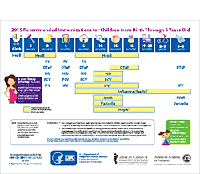Haemophilus Influenza Type B (Hib) Vaccine Safety
Hib and How to Protect Against It
Haemophilus influenzae type b (Hib) is a type of bacteria that can cause severe illness, including infections of the covering of the brain and spinal cord (meningitis), lung infections (pneumonia), and severe throat infections (epiglottitis). You can protect against Hib with safe, effective vaccination.
Hib Vaccine Side Effects
The Hib vaccine is very safe, and it is effective at preventing Hib. Vaccines, like any medicine, can have side effects. Most people who get Hib vaccine do not have any problems with it.
Common Side Effects of Hib Vaccine
- Redness, warmth, or swelling from the shot
- Fever
When these side effects happen, they usually start within a day of vaccination and last up to 3 days. On very rare occasions, people have had severe (anaphylactic) allergic reactions to the vaccine.
Available Hib Vaccines
There are six Hib vaccines approved for use in the United States, three of which are combined with vaccines for other diseases:
Hib-only Vaccines:
- PedvaxHIB[PDF – 82 KB] : The Food and Drug Administration (FDA) approved this vaccine in 1989. It is usually given to children 2 through 15 months of age.
- ActHIB[PDF – 278 KB]: FDA approved this vaccine in 1993. It is usually given to children who are 2 through 15 months of age.
- Hiberix[PDF – 123 KB]: FDA approved this vaccine in 2009. It is given as a booster dose in children who are 15 months through 4 years of age.
Combination Vaccines:
- Comvax [PDF – 101 KB]: FDA approved this vaccine in 1996 for use in children who are 6 weeks through 15 months of age. It protects against Hib and Hepatitis B.
- Pentacel [PDF – 325 KB]: FDA approved this vaccine in 2008. It is usually given to children who are 2 through 18 months of age to protect Hib, diphtheria, tetanus, pertussis, and polio.
- MenHibRix [PDF – 1.43 MB]: FDA approved this vaccine in 2012. It is usually given to children who are 2 through 15 months of age to protect against Hib and meningococcal serogroup C and Y disease.
How CDC Monitors Hib Vaccine Safety
CDC and FDA continuously monitor the safety of vaccines after they are approved. If a problem is found with a vaccine, CDC and FDA will inform health officials, health care providers, and the public.
CDC uses three systems to monitor vaccine safety:
- The Vaccine Adverse Event Reporting System (VAERS): an early warning system that helps CDC and FDA monitor problems following vaccination. Anyone can report possible vaccine side effects to VAERS.
- The Vaccine Safety Datalink (VSD): a collaboration between CDC and nine health care organizations which allows ongoing monitoring and proactive searches of vaccine-related data.
- The Clinical Immunization Safety Assessment (CISA) Project: a partnership between CDC and several medical centers that conducts clinical research on vaccine-associated health risks.
A Closer Look at the Safety Data
- A study of the safety of Hib vaccines (PedvaxHIB, ActHIB, Hiberix, Comvax, Pentacel) in VAERS did not find any new or unexpected safety concerns and reconfirmed the safety of Hib vaccines.
- An additional evaluation of Comvax showed no concerning safety patterns.
- A study using VSD records did not find an increased risk for seizures, meningitis/encephalitis/myelitis, allergic reactions, or fever among children younger than 1 year of age.
More Resources
- Hib Vaccine Information Statement
- Hib Vaccine: Who Should Not Get Vaccinated
- Immunization Action Coalition: Fact Sheet on Hib Vaccine
- U.S. Vaccine Abbreviations [PDF – 196 KB]
Related Scientific Articles
Black S, Greenberg DP. A combined diphtheria, tetanus, five-component acellular pertussis, poliovirus, and Haemophilus influenzae type b vaccine. Expert Rev Vaccines 2005 Dec;4(6):793-805.
CDC. Prevention and Control of Haemophilus influenzae type b Disease: Recommendations of the Advisory Committee on Immunization Practices (ACIP). MMWR. 2014;63(No. RR-1):1-14.
Davis RL, Black S, Shinefield H, Mahoney L, Zavitkovsky A, Lewis E, et al. Post-marketing evaluation of the short term safety of COMVAX. Vaccine. 2004 Jan 2;22(3-4):536-43.
Decker MD, Edwards KM, Bradley R, Palmer P. Comparative trial in infants of four conjugate Haemophilus influenzae type b vaccines. J Pediatr. 1992 Feb;120(2 Pt 1):184-9.
Fritzell B, Plotkin S. Efficacy and safety of a Haemophilus influenzae type b capsular polysaccharide-tetanus protein conjugate vaccine. J Pediatr. 1992 Sep;121(3):355-62.
Guerra FA, Blatter MM, Greenberg DP, Pichichero M, Noriega FR. Pentacel Study Group. Safety and immunogenicity of a pentavalent vaccine compared with separate administration of licensed equivalent vaccines in US infants and toddlers and persistence of antibodies before a preschool booster dose: A randomized, clinical trial. Pediatrics. 2009 Jan;123(1):301-12.
Holmes SJ, Fritzell B, Guito KP, Esbenshade JF, Blatter MM, Reisinger KS, et al. Immunogenicity of Haemophilus influenzae type b polysaccharide-tetanus toxoid conjugate vaccine in infants. Am J Dis Child. 1993 Aug;147(8):832-6.
Moro PL, Jankosky C, Menschik D, Lewis P, Duffy J, Stewart B, et al. Adverse events following Haemophilus influenzae type b (Hib) vaccines in the Vaccine Adverse Event Reporting System (VAERS), 1990-2013. J Pediatr. 2015 Apr;166(4):992-7.
Nelson JC, Yu O, Dominguez-Islas CP, Cook AJ, Peterson D, Greene SK. Adapting group sequential methods to observational postlicensure vaccine safety surveillance: Results of a pentavalent combination DTaP-IPV-Hib vaccine safety study. Am J Epidemiol. 2013 Jan 15;177(2):131-41.
Rinderknecht S, Bryant KA, Nolan T, Pavia-Ruz N, Doniz CA, Weber MA, et al. The safety profile of Haemophilus influenzae type b-Neisseria meningitidis serogroups C and Y tetanus toxoid conjugate vaccine (HibMenCY). Hum Vaccin Immunother. 2012 Mar;8(3):304-11.
- Page last reviewed: October 27, 2015
- Page last updated: October 27, 2015
- Content Source:


 ShareCompartir
ShareCompartir
